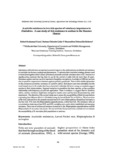Please use this identifier to cite or link to this item:
https://cris.library.msu.ac.zw//handle/11408/681| Title: | Acaricide resistance in two tick species of veterinary importance in Zimbabwe: a case study of tick resistance to amitraz in the Mazowe district | Authors: | Gono, Robert K. Chireshe, Fortunate Muzondiwa, John V. Sichewo, Petronilla |
Keywords: | Acaricide resistance, larval packet test, rhipicephalus B microplus | Issue Date: | 2014 | Publisher: | Midlands State University | Series/Report no.: | Midlands State University Journal of Science, Agriculture and Technology;Vol. 5 (1); p. 111-120 | Abstract: | Infestations with ticks have an important economic impact on the cattle industry worldwide and resistance to acaricides has become a widespread phenomenon. To optimize their treatment strategy, farmers need to know if and against which classes of livestock, potential acaricide-resistance does occur. Amitraz is a rapidly acting acaricide that has been in use for the control of cattle ticks for more than 30 years. Resistance against amitraz was first reported in Boophilus microplus in Australia in 1980 but has been slow to spread in comparison to resistance against synthetic pyrethroids. There is little reliable information on the prevalence of amitraz resistance in southern Africa. Risk factors have been identified, but the small sample sizes in the studies that have attempted to identify risk factors using survey data suggest caution in their interpretation. Regional variation in prevalence has been reported, as has a positive relationship with frequency of acaricide application. There is evidence to suggest that in Southern Africa, amitraz resistance might have emerged in isolated areas and has been disseminated by cattle movements. The objective of the current study was to assess the susceptibility of field tick populations originating from Mazowe district in Zimbabwe using the Larval Packet Test to Amitraz. The proportions of the ticks collected from the animals revealed that 61% were Rhipicephalus (Boophilus} microplus a one host tick. 31% were the Rhipicephalus appendiculutus, a three host tick. The resistance ratios at concentrations inducing at least 80% and 99% mortality were used to detect established and emerging resistance. There was no evidence of resistance to amitraz in the. Rhipicephalus appendiculutus and the Rhipicephalus B microplus tick species. The Larval Packet Test proved to be a suitable test to evaluate the susceptibility of R. microplus field populations to amitraz. | URI: | http://hdl.handle.net/11408/681 |
| Appears in Collections: | Research Papers |
Show full item record
Page view(s)
132
checked on Apr 11, 2025
Download(s)
88
checked on Apr 11, 2025
Google ScholarTM
Check
Items in MSUIR are protected by copyright, with all rights reserved, unless otherwise indicated.




